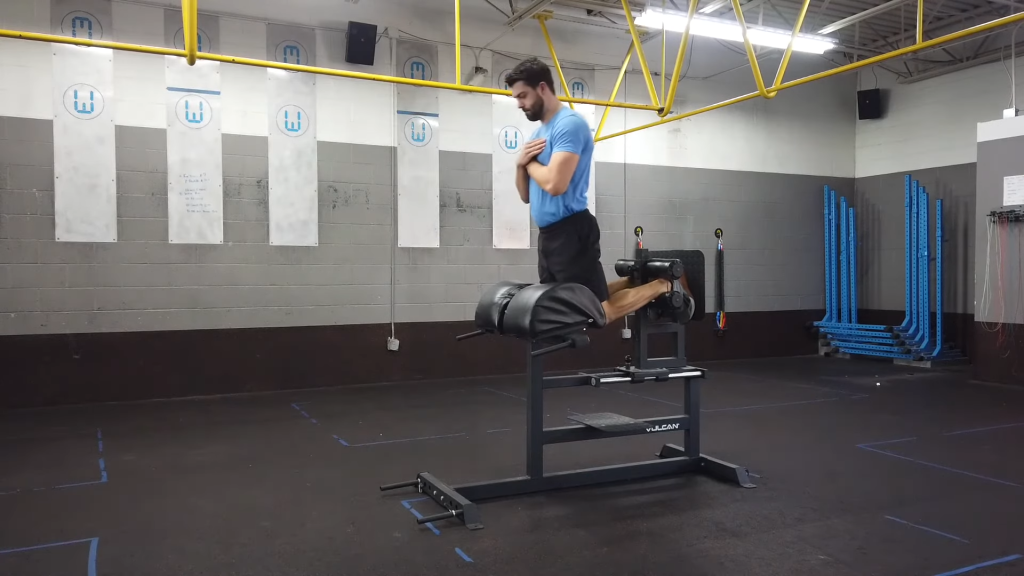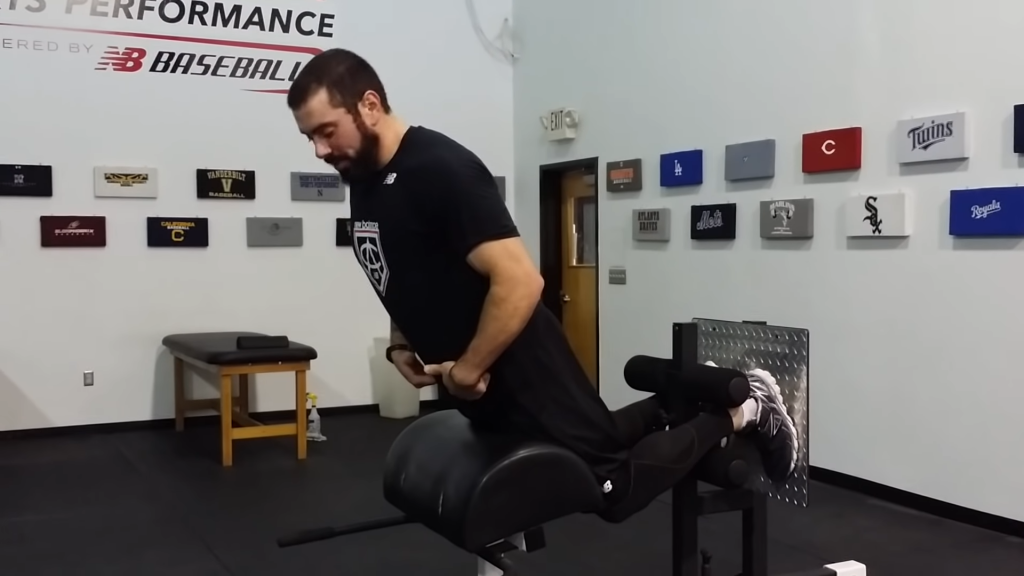Mastering the Glute-Ham Raise Exercise: A Step-by-Step Guide
September 18, 2023

Are you looking to level up your lower body workout? Look no further than the glute-ham raise exercise! This powerful movement targets your glutes, hamstrings, and even your core. And the best part? You can do it without any fancy equipment. In this step-by-step guide, we'll explore everything you need to know about the glute-ham raise exercise and how to master it like a pro.

Understanding the Glute-Ham Raise Exercise
Before we dive into the details, let's take a moment to understand the benefits of glute-ham raises and the muscles they target. You might be wondering, "Why should I incorporate this exercise into my routine?" Great question! Glute-ham raises not only help you build stronger glutes and hamstrings but also improve your overall performance in other lower body exercises.
When performing glute-ham raises, your glutes, hamstrings, and even your core work together to execute each rep. By strengthening these muscle groups, you'll enhance your athletic abilities, increase lower body power, and gain stability during compound movements like squats and deadlifts. Who doesn't want a rock-solid foundation, right?
But let's explore the benefits of incorporating glute-ham raises into your exercise routine in more detail.
Exploring the Benefits of Glute-Ham Raises
Before we jump into the step-by-step guide, let's explore the specific benefits of incorporating glute-ham raises into your exercise routine.
- Stronger glutes: Glute-ham raises target your gluteus maximus, the largest muscle in your buttocks. By working it consistently, you'll achieve a rounder, perkier backside. But that's not all! Strong glutes also contribute to better posture and can alleviate lower back pain.
- Hamstring hypertrophy: Glute-ham raises are one of the most effective exercises for building strong and defined hamstrings. Get ready to rock those shorts with confidence! Not only will your hamstrings look great, but they'll also provide stability to your knees, reducing the risk of injury.
- Improved athletic performance: Stronger glutes and hamstrings mean improved explosive power, speed, and agility. Whether you're a runner, a soccer player, or just love to stay active, glute-ham raises will take your performance to the next level. You'll be able to sprint faster, jump higher, and change direction with ease.
- Reduced risk of injury: A strong posterior chain is essential for injury prevention. Glute-ham raises help build strength in your glutes, hamstrings, and lower back, reducing the risk of strains and imbalances. By strengthening these muscles, you'll also improve your stability and balance, making you less prone to falls and other accidents.
Targeted Muscles in Glute-Ham Raises
Now that we know why glute-ham raises are worth including in your workout routine, let's dig deeper into the specific muscles that this exercise targets.
The primary muscles worked during glute-ham raises include:
- Gluteus Maximus: This is your largest glute muscle responsible for hip extension. It's not just about aesthetics; a strong gluteus maximus helps you generate power and speed in movements like running and jumping.
- Hamstrings: These muscles, located at the back of your thighs, bend your knees and extend your hips. Strong hamstrings not only improve your athletic performance but also protect your knees from injury.
- Erector Spinae: The muscles of your lower back, erecting and extending your spine during the exercise. Strengthening the erector spinae helps maintain a healthy posture and reduces the risk of lower back pain.
- Core Muscles: Your core plays a crucial role in stabilizing your body during glute-ham raises, ensuring proper form and preventing injury. A strong core not only enhances your performance in other exercises but also improves your overall balance and stability.
Mastering the Proper Form for Glute-Ham Raises
Now that you understand the fantastic benefits and targeted muscles of glute-ham raises, let's dive into the step-by-step guide to performing this exercise with perfect form.
Step-by-Step Guide to Performing Glute-Ham Raises Correctly
Step 1: Set up your equipment. You don't need any fancy machines for this exercise. Find a stable surface to anchor your feet, or ask a workout buddy to hold them down.
Glute-ham raises are a highly effective exercise that primarily targets the glutes and hamstrings. By performing this exercise with proper form, you can maximize the benefits and minimize the risk of injury. Let's explore the step-by-step guide in detail.
Step 2: Position yourself on the ground with your knees on a soft surface and your feet anchored. Your thighs should be parallel to the ground, and your upper body should be upright, forming a straight line.
It is crucial to maintain the correct body position throughout the exercise. By aligning your thighs parallel to the ground and keeping your upper body upright, you engage the targeted muscles effectively. This alignment also helps in stabilizing your core and maintaining balance.
Step 3: Slowly lower your upper body while maintaining a straight line. Use your glutes and hamstrings to control the movement as you descend towards the floor.
As you descend towards the floor, focus on engaging your glutes and hamstrings to control the movement. This controlled descent not only activates the targeted muscles but also helps in building strength and stability in the lower body.
Step 4: Initiate the rise by contracting your glutes and hamstrings, lifting your upper body back to the starting position. Keep your movement smooth and controlled throughout.
When initiating the rise, concentrate on contracting your glutes and hamstrings. This contraction generates the force required to lift your upper body back to the starting position. It is crucial to maintain a smooth and controlled movement to avoid any jerking or sudden movements that may lead to strain or injury.
Step 5: Repeat for the desired number of reps. Start with a manageable number and gradually increase as your strength and conditioning improve.
As with any exercise, it is essential to start with a manageable number of repetitions and gradually increase as your strength and conditioning improve. By gradually progressing, you allow your muscles to adapt and grow stronger over time, reducing the risk of overexertion or injury.
By following this step-by-step guide and focusing on proper form, you can master the glute-ham raise exercise and reap its numerous benefits. Remember to always listen to your body, take breaks when needed, and consult a fitness professional if you have any concerns or questions.

Effective Glute-Ham Raise Variations
Now that you've nailed the basic glute-ham raise, let's spice things up with some exciting variations!
But first, let's take a moment to understand the importance of glute-ham raises in your lower body strength training routine. Glute-ham raises primarily target the glutes, hamstrings, and lower back muscles, making them a fantastic exercise for building strength and power in your posterior chain. By incorporating these variations into your workout, you'll not only challenge your muscles in new ways but also enhance your overall performance.
Try the Nordic Hamstring Curl for a Challenge
This advanced variation will take your glute-ham raise game to new heights! Start in the same position as a regular glute-ham raise, but instead of anchoring your feet, position a partner or weighted object on your feet to create resistance. Slowly descend towards the ground while maintaining control, and then powerfully contract your hamstrings to return to the starting position. Feel the burn!
The Nordic hamstring curl is a popular exercise among athletes and fitness enthusiasts due to its ability to strengthen the hamstrings, which are crucial for explosive movements like sprinting and jumping. By incorporating this variation into your routine, you'll not only challenge your muscles but also improve your athletic performance.
Slider Hamstring Curl: A Creative Alternative
No equipment? No problem! If you have a smooth surface like hardwood or tile, grab a pair of sliders or use a towel under your feet. Assume the starting position of a regular glute-ham raise and use your sliders or towel to slide your feet back towards your glutes. Engage your hamstrings to push your feet back out and return to the starting position. It's like a glute-ham raise meets a graceful ice-skating routine!
The slider hamstring curl is a great alternative for those who don't have access to specialized equipment. By using sliders or a towel, you can mimic the movement of a glute-ham raise while engaging your hamstrings and challenging your stability. Plus, the sliding motion adds an element of fun and creativity to your workout!
Banded Rolling Hamstring Curl: Adding Resistance
To add resistance and give your hamstrings an extra challenge, grab a resistance band and anchor it around a sturdy object. Secure the band around your feet and assume the starting position. As you lower your upper body, the band will provide additional resistance, making your hamstrings work even harder. Prepare for some serious posterior chain gains!
The banded rolling hamstring curl is an excellent variation for those looking to intensify their glute-ham raise workout. By adding a resistance band, you're increasing the load on your hamstrings, forcing them to work harder and promoting muscle growth. This variation is perfect for individuals who want to take their lower body strength to the next level.
Strengthen Your Core with Leg-Banded Ab Rollouts
Looking to engage your core while targeting your glutes and hamstrings? Look no further than leg-banded ab rollouts! Secure a resistance band around a stationary object and attach the other end to the back of your ankles. Assume a plank position with your hands on a stable surface, and roll the resistance band towards your ankles using your core muscles. Talk about a full-body burn!
The leg-banded ab rollout combines the benefits of glute-ham raises with core-strengthening exercises. By incorporating resistance bands into your ab rollout, you're not only challenging your core muscles but also engaging your glutes and hamstrings. This variation is perfect for individuals who want to work multiple muscle groups simultaneously and achieve a well-rounded workout.
Combine Back Extension and Leg Curl for a Full-Body Workout
If you're looking to maximize your glute-ham raise gains, try combining the movement with a back extension. Perform a back extension exercise on a glute-ham raise machine, followed immediately by a glute-ham raise. This combination creates an intense full-body workout that will leave you feeling challenged and accomplished.
The combination of back extensions and glute-ham raises is a powerful way to target your entire posterior chain. By alternating between these two exercises, you're not only strengthening your glutes, hamstrings, and lower back but also improving your overall stability and balance. This full-body workout is perfect for individuals who want to challenge themselves and achieve a well-rounded physique.
Now that you have a comprehensive guide to glute-ham raises and their variations, it's time to take action! Whether you're a seasoned gym-goer or just starting your fitness journey, mastering this exercise will undoubtedly take your lower body strength and power to new heights. So grab a partner, find a stable surface, and let the glute-ham raise madness begin!

 Back to Blog
Back to Blog